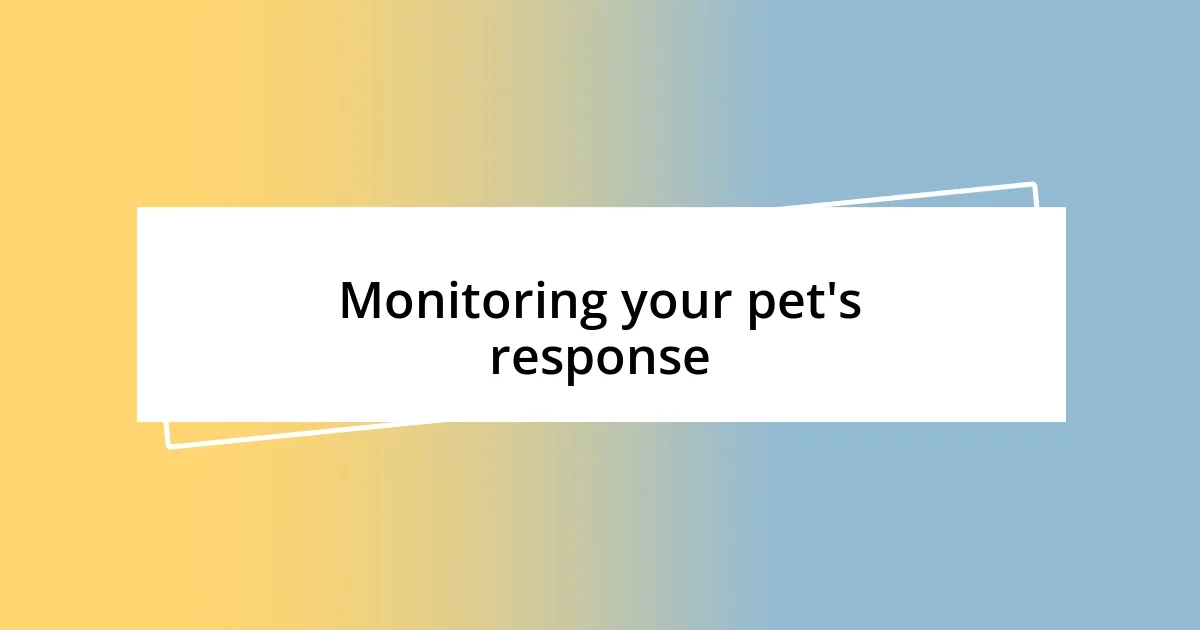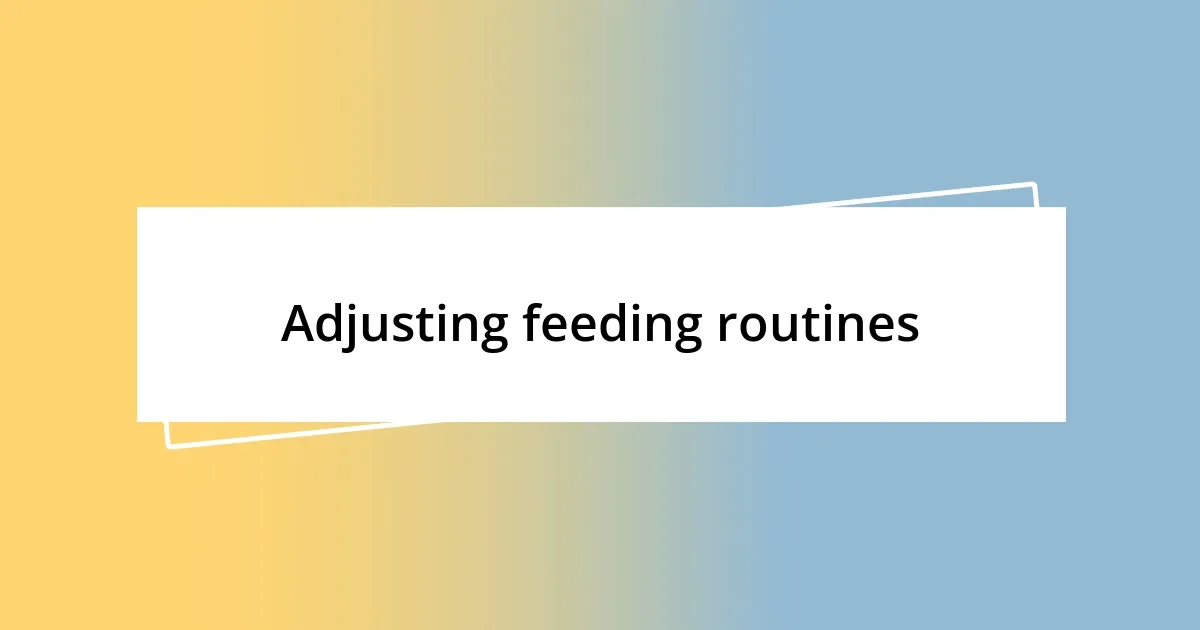Key takeaways:
- Understanding your pet’s individual needs is crucial for choosing the right food and ensuring their health and happiness.
- Introduce new food gradually to prevent digestive issues and allow pets to acclimate comfortably.
- Monitor your pet’s response during the transition, paying attention to behavior, stool changes, and overall well-being.
- Adjust feeding routines mindfully to help pets feel secure and adapt better to dietary changes.

Understanding your pet’s needs
Understanding your pet’s needs is not just about knowing what food they eat; it’s about observing their behavior, health, and preferences. For instance, when I switched my dog’s food, I noticed she was more energetic and excited at mealtime. This small shift made me realize that her previous food wasn’t just unpalatable—it didn’t support her well-being as much as I thought.
Think about your pet’s specific needs based on breed, age, and any health concerns. When I adopted my cat, I learned that her age required different nutrients compared to my older dog. It was fascinating to dive into how each pet can thrive when we pay attention to these individualized requirements.
Have you ever wondered how your pet might feel about their food? I remember the first time I introduced a new flavor to my dog. Her curious sniffing and hesitant licking told me all I needed to know about her preferences. This experience taught me that tuning into our pets’ reactions can lead to healthier, happier choices.

Choosing the right new food
Choosing the right new food for your pet can feel overwhelming, but it doesn’t have to be. I remember selecting a new kibble for my dog after doing some research. There were so many brands and options! I quickly realized that just looking at the pretty packaging wouldn’t cut it. Instead, I focused on the ingredients and nutrition labels, prioritizing high-quality proteins and whole grains that would be beneficial for her health.
Here are some key factors to consider when choosing a new food for your pet:
- Ingredients: Look for whole food ingredients and avoid those with fillers or artificial additives.
- Life Stage: Ensure the food is appropriate for your pet’s age, as puppies, adults, and seniors have different nutritional needs.
- Health Concerns: If your pet has allergies or health issues, consult your vet for recommendations tailored to their specific condition.
- Taste and Texture: Pets can be picky! I found that my dog preferred a grain-free option, which she was visibly excited to eat.
- Brand Reputation: Research the brand’s history and read reviews to gauge others’ experiences.
Trust me, taking the time to choose the right new food will make a significant difference in your pet’s lifestyle. I saw an immediate change in my dog’s coat and energy levels, and it was so rewarding to know that I made the right choice for her health.

Gradual introduction of new food
When it comes to transitioning your pet to new food, a gradual introduction is key. I learned this the hard way when I tried to switch my dog’s food too quickly, which led to some uncomfortable digestive issues. Instead, I started by mixing a small amount of the new food with her old food. Gradually increasing the proportion over about a week made a world of difference, and she adjusted surprisingly well.
The way I approached this process involved patience and observation. At first, I noticed that my dog was a bit hesitant, only picking out the old kibble. I was concerned she wouldn’t accept the new food at all. However, after a couple of days, she began to dig in with more enthusiasm. It taught me that just like us, pets appreciate a gradual shift and time to acclimate to changes in their diet.
It’s crucial to monitor your pet’s response during this transition. I kept an eye on her stool consistency and overall behavior. If she seemed lethargic or had any gastrointestinal upset, I would have slowed down the transition further. Thankfully, it was smooth sailing for my pup, which left me reassured that taking my time had proven beneficial.
| Old Food Proportion | New Food Proportion | |
|---|---|---|
| Day 1-2 | 75% | 25% |
| Day 3-4 | 50% | 50% |
| Day 5-6 | 25% | 75% |
| Day 7 | 0% | 100% |

Monitoring your pet’s response
Monitoring your pet’s response is an essential part of the transition process. I vividly remember the first few days after switching my dog’s food. I was constantly evaluating whether her energy levels were stable or if there were any signs of distress, like excessive whining or constant trips to the backyard. This close monitoring made all the difference; it reassured me that I was doing right by her.
Pay attention to changes in your pet’s stool. I often found myself nervous when I noticed slight variations, but I learned that small changes can be perfectly normal. For instance, during the transition, my dog had a couple of softer stools. At first, it frightened me, but then I realized it was part of her body adjusting to the new ingredients. Recognizing these patterns helps to distinguish between what’s normal and what might indicate a problem.
Consider how your pet reacts behaviorally too. Is there excitement during meal times, or does their interest seem flat? For me, watching my dog eagerly run to her bowl was a comforting sign. If she hadn’t responded positively, I’d have revisited my approach. It’s that kind of attentiveness that keeps me connected to her well-being, turning a simple meal transition into a bonding experience. How does your pet express their feelings about new food? These moments can reveal so much about their comfort and happiness.

Adjusting feeding routines
Adjusting feeding routines can feel like an intricate dance with your pet, especially during a food transition. I remember the first time I changed my cat’s feeding schedule; it was a bit of a struggle at first. By gradually shifting mealtimes, I found a rhythm that accommodated her needs while allowing me to maintain a consistent approach. Starting with small adjustments, like changing her feeding time by just 15 minutes each day, helped her adapt without causing any stress.
I realized that simply altering the type of food wasn’t enough; the timing of the meals played a crucial role, too. My dog, who’s usually a morning enthusiast, began to associate new feeding times with excitement rather than anxiety. There was a noticeable change in her demeanor—she became more relaxed and even started showing eagerness by waiting patiently by her bowl. This shift was enlightening for me; it underscored how pets can have their preferences and that being mindful of their habits is key in making a successful transition.
Have you considered how your pet might react to shifts in their feeding routine? Reflecting on my experience, I learned that consistency is vital. Whether it’s mealtime or the type of food, pets thrive on familiarity. So, ensuring that their daily routine has some stable elements can create a comforting environment amidst the changes. After all, we all want our furry friends to feel secure and happy during transitions, don’t we?

Common challenges during transition
One common challenge during the transition to a new food is your pet’s potential reluctance to try it. I remember when I switched my dog’s diet; she sniffed her bowl suspiciously as if I had committed some culinary crime. It’s heartbreaking to watch them turn away from something that’s supposed to be delicious. Have you experienced a similar situation? My solution was to mix a little of her favorite treat into the new food, which sparked her curiosity and made her more willing to give it a try.
Another hurdle can be digestive upset. Initially, my cat had an unexpected bout of nausea, which sent me into a panic. I was worried she might not adapt at all! It taught me how sensitive pets can be to dietary changes. I learned from that experience to break the transition into smaller increments, allowing her to adjust gradually. This approach minimized the upset and ultimately made the process smoother for both of us. Have you considered how slowly introducing new food might affect your pet?
Moreover, behavioral changes often crop up during this period. I vividly recall my dog being grumpy and less playful right after the switch. I felt like I was navigating through fog—nothing seemed right. It was a reminder that pets can be deeply affected by changes. In hindsight, those shifts in mood just signaled that she needed more time to adapt. Have you monitored any subtle changes in your pet’s behavior? Paying close attention to these cues can guide your approach, making the transition not just smoother but also a stronger bonding experience.

Tips for a successful transition
I’ve found that starting with a gradual mix of old and new food can be incredibly effective. When I transitioned my cat to a different brand, I began by adding just a small amount of the new food to her usual kibble. Watching her tentatively sniff and taste the mix was both amusing and reassuring. Have you ever noticed how pets can surprise us with their reactions? Each day, I incrementally increased the new food while reducing the old, which minimized her chances of rejection or discomfort.
Something else that truly made a difference was keeping an eye on her bowl. Initially, I became anxious when she didn’t dive in right away. But I learned to be patient. Sometimes, simply leaving the food out for a while gave her the time she needed to explore it at her own pace. I found that weaving in positive reinforcement—like treating her with a gentle pet or praise when she did try it—created a positive association. Have you considered how much our reactions can impact our pets’ experience?
Finally, I realized that environment matters tremendously during this process. I chose quiet moments, free from distractions, to offer her meals. The first night I set her food down and watched from a distance almost felt like a bonding exercise. It was heartwarming to see her cautiously approach her bowl instead of feeling pressured. Have you thought about how your presence affects your pet’s comfort level? Allowing them space can foster trust, which is crucial as they adapt to something as simple, yet significant, as a new meal.














